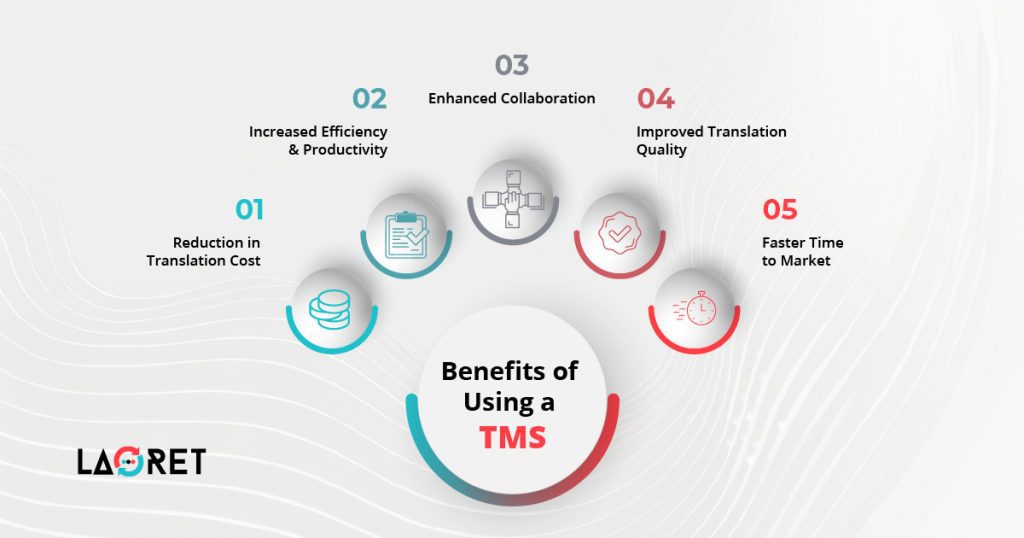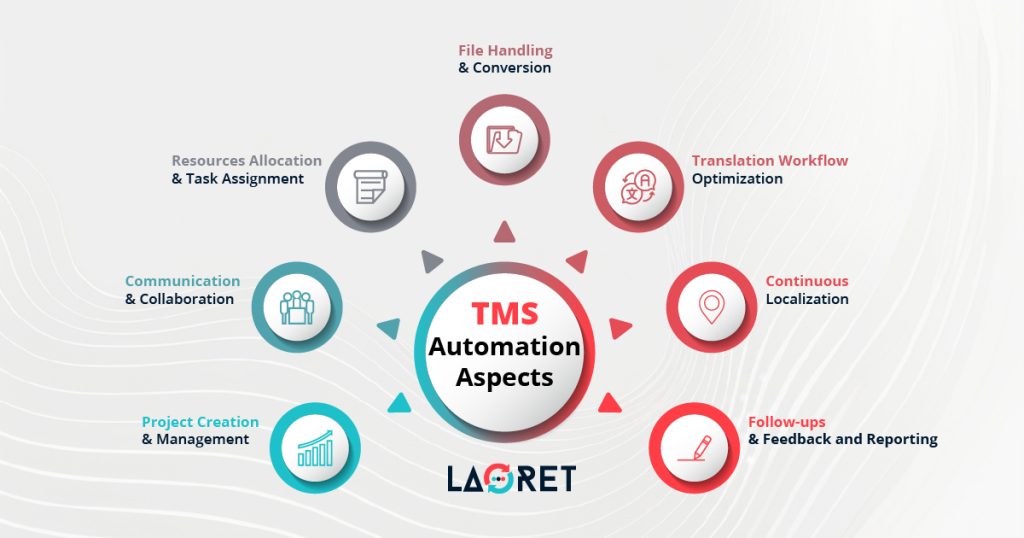Translation Management System: Human Experts Meet Automation
Expanding your business globally starts with effective translation. Yet, traditional manual translation processes can be incredibly complex and overwhelming, involving a complex network of translators, reviewers, quality checkers, designers, and localization experts.
Managing these elements manually is not only time-consuming but can also delay your entry into global markets, impeding your growth and expansion.
Imagine if there were a solution that could streamline this process, save time, and guarantee quality. A powerful Translation Management System (TMS) can do just that, opening up a world of opportunities for your business.
In this post, we’ll unveil the game-changing benefits of a TMS and explore its key features that transform chaotic translation processes into streamlined, efficient custom workflows. You’ll discover why a TMS is essential for any business serious about making its mark on the global stage.
Let’s dive into this transformative tool.
What is a Translation Management System (TMS) & Who Benefits from It?
A Translation Management System (TMS) is a software platform designed to streamline and automate the translation and localization process. It acts as a central hub for all translation-related tasks, connecting stakeholders, managing resources, and ensuring consistency and efficiency.
Think of it as a project management tool specifically designed for multilingual content.
Who Benefits from a TMS?
A wide range of stakeholders can benefit from using a TMS, including:
- Businesses Expanding Globally
- Translators and Localization Experts
- Project Managers
- Content Creators and Marketers
- Clients and End Users
Generally speaking, a TMS benefits anyone involved in creating, translating, or managing multilingual content. It simplifies complex processes, improves efficiency, and ensures high-quality translations, making it an invaluable tool for businesses aiming to thrive in the global marketplace.
Key Benefits of Translation Management Software
Translation management software offers a wide range of key benefits that can significantly impact businesses in a positive way. Here are the most 5 benefits your business can feel.
Reduced Translation Costs:
First and foremost, the software can lead to reduced translation costs. By automating and streamlining the translation process, businesses can save both time and money by avoiding the need for manual translation services or expensive outsourcing.
How Does This Work?
TMS benefits from the integrated Translation memory, which reuses previously translated content. This reduces redundant work and lowers per-word translation costs over time.
Increased Efficiency and Productivity:
Moreover, translation management software can lead to increased efficiency and productivity within an organization. It allows for better management of translation projects, automates repetitive tasks, and provides a centralized platform for all translation-related activities. This translates to faster turnaround times and the ability to handle larger volumes of content without sacrificing quality, boosting overall productivity. Features like automated file handling and task assignment eliminate time-consuming manual work.
Enhanced Collaboration:
Enhanced collaboration is another crucial benefit of translation management software. With features such as real-time collaboration, centralized glossaries, and translation memory, team members can work together seamlessly, leading to improved consistency and accuracy in translations. It ensures everyone has access to the latest resources and project updates. The result is smoother teamwork and fewer misunderstandings.
Improved Translation Quality:
Quality assurance tools, terminology management, and style guides built into TMS help maintain consistency across all translations. This leads to higher-quality outputs and reduces the need for extensive revisions. maintaining brand integrity and effectively communicating with their target audience. The system can also facilitate multiple review stages to catch and correct errors
Faster Time to Market:
TMS significantly reduces project turnaround times as it optimizes the entire localization workflow. This allows businesses to launch products and content in new markets more quickly, reducing time to market and giving them a competitive edge. The ability to manage multiple languages simultaneously further accelerates global rollouts.
To fully embrace this technology and understand its intricacies, it is essential to familiarize yourself with its features. So, let’s take a deeper look!
Streamlining Workflow with a Translation Management Solution: Top Features Revealed
Automation
A key feature of Translation Management Systems is their powerful automation capabilities, which can significantly reduce manual effort and streamline complex processes.
Here are some key automation features of an efficient TMS that you should know about:
Automatic Importing and Exporting of Resource Files: Traditionally, managing resource files requires manual handling. For example, in a website localization project, you would typically need to copy and paste a large number of strings, which is impractical. An efficient TMS offers seamless import and export functionality that supports various file formats and automatically identifies and retrieves content for translation.
Continuous Translation: The consistent flow of importing and exporting content also supports continuous localization. For instance, in mobile app localization, regular updates in features and content are common. A TMS ensures that this process runs smoothly by regularly importing, translating text, and exporting your content.
Integration
While automation streamlines individual tasks, the true power of a TMS lies in its ability to integrate with other localization tools, creating a connected translation ecosystem. This integration is crucial for achieving consistent, high-quality, and cost-effective translations, especially for large-scale projects.
Here’s how integration elevates the capabilities of a TMS:
1. Harnessing the Power of CAT Tools:
A cornerstone of TMS integration is its seamless connection with (CAT) Tools. These tools are indispensable for managing complex translation projects and ensuring linguistic excellence. Because of the features it has such as:
| Feature | Description | Benefits |
| Translation Memory (TM) | Dynamic database storing previously translated segments, sentences, and terminology. | Ensures consistency across projects and reduces translation time and costs by leveraging existing translations. |
| Glossaries and Style Guides | Integrates client-provided glossaries and style guides directly into the workflow. | Guarantees accurate use of product-specific terminology and adherence to brand voice and style preferences. |
| Segmentation | Break down large text blocks into smaller, manageable segments. | Facilitates efficient translation and leverages TM for maximum reuse. |
| Quality Assurance | Provides tools for real-time error detection. | Ensures high-quality translations from the start. |
2. Seamless In-Context Editing:
As you may well know, during translation, text expansion or contraction happens. Usually, this technicality requires back-and-forth communication between the linguistic and development teams to make sure the translation doesn’t compromise the user interface (UI).
But not anymore!
With this live editing feature, you or your linguistic team can add the translation to your app or website in real time, where the translation (or any changes) can appear instantly to make sure it fits and flows well within the design and maintain UI integrity.
Additionally, the TMS provides the capability to upload screenshots, offering translators visual context. This enables them to see where the translation will appear in the design and adjust translations to fit the layout and design elements.
3. Leveraging Machine Translation (MT):
Integration with MT engines automates the initial translation process, generating a raw output that serves as a starting point for human translators.
And then here comes the role of the human in the picture.
TMS facilitates a powerful combination of MT and human expertise through Machine Translation Post-Editing where translators refine the MT output, ensuring accuracy, fluency, and cultural appropriateness.
The result is…
a TMS creates a unified translation environment that optimizes efficiency, consistency, and quality. This integration is key to unlocking the full potential of your translation workflow and achieving global success.
Third-Party Integrations
The power of a Translation Management System (TMS) extends far beyond its core features. Through third-party integrations, your TMS becomes a versatile hub that seamlessly connects with the tools your team already uses.
Let’s explore how these integrations can transform your workflow:
Design Tool Integration
Imagine your designers working directly in Adobe InDesign with multilingual content at their fingertips. This integration allows your Desktop Publishing team to access and modify designs across languages, ensuring visual consistency and streamlining the adaptation process.
Content Management System (CMS) Integration
Say goodbye to boring copy-pasting. Your TMS can connect with popular CMS platforms like WordPress or Drupal, where you effortlessly import and export content for website localization. As a bonus, you’ll get precise word counts straight from your CMS, making project quotes more accurate than ever.
Engineering Tool Integration
For software developers, integrating your TMS with tools like Jenkins, Grunt, or Docker is a game-changer. This localization tool setup supports continuous localization, keeping your software up-to-date for global audiences without manual intervention.
Project Management Integration
Keep your entire team in sync by linking your TMS with project management tools like Trello or Asana. This integration streamlines communication, provides real-time progress tracking, and ensures everyone has access to the information they need when they need it.
So the result?
Improved transparency and smoother workflows across your localization projects.
Collaboration
A Translation Management System is optimized with Project Management Assets which supports a collaborative environment where the entire translation team can work from a single platform.
While the TMS was initially intended to support the work of linguists, it has since become a valuable tool for Project Managers to maintain optimal collaboration across different departments.
The Translation Management System will offer a host of analytics that can prove indispensable when organizing a team and keeping track of translation projects.
These commonly work on three levels, which are:
- Team-level analytics that monitors all levels of user activity including the number of projects that are created and their timelines.
- Project-level analytics help Project Managers understand who is involved in every project and how close this project is to completion.
- Translation Analytics where things such as word count and translator profiles can be tracked.
Data Protection
Since highly sensitive information may be communicated through the TMS, data protection is a priority. A TMS can provide a secure workspace. You can rest assured all data are securely stored on cloud servers.
Additionally, a TMS helps keep all your payment information highly secure and safe in one place.
Laoret: Your Trusted Partner
While some prefer to manage translations in-house with a TMS, others find greater value in partnering with a Language Service Provider (LSP) like Laoret. LSPs offer a fully optimized translation ecosystem, combining cutting-edge technology with expert linguistic talent.
At Laoret, we’ve developed our own proprietary tools and leverage a sophisticated TMS to deliver exceptional quality at competitive rates. Our unique blend of automation and human expertise ensures fast turnaround times without compromising on accuracy or cultural nuance.
Ready to unlock the power of global communication? Contact us today and let’s discuss how Laoret can help you achieve your international ambitions.








